- August 18, 2016
- By Maryland Today Staff
More than a billion years ago, a pair of black holes—collapsed stars with gravity strong enough to ensnare light and bend time—spiraled together and violently merged. Like waves from a rock thrown into a lake, the titanic collision caused “ripples” in the fabric of the universe that radiated outward. Last fall, just as the $620 million Laser Interferometer Gravitational-Wave Observatory (LIGO) was switched back on after a major upgrade, one of them reached Earth.
At a February press conference, leaders of the 1,000-member LIGO team, which includes several University of Maryland researchers, announced the first-ever detection of gravitational waves, promising a new way to observe events in space. In blogs and on newscasts and front pages around the world, it was hailed as one of the greatest discoveries of recent decades.
The news had a familiar ring. Nearly 50 years earlier, a lone UMD professor generated similar fanfare with the same revelation.
In 1969, Joseph Weber, one of the 20th century’s most brilliant and idiosyncratic physicists, announced that two instruments he’d built—one in a small cinderblock building hidden in the woods at the University Golf Course, the other at Argonne National Laboratory near Chicago—had simultaneously registered a gravitational wave.
This apparent verification of Einstein’s theory of general relativity—the great physicist himself considered gravitational waves too weak to observe—gained Weber widespread fame and made him a leader of an area of physics previously considered impossible to pursue. Early on, Weber had relished having an extreme frontier of science nearly to himself. But now physicists around the world, entranced by his findings, were dropping other projects to follow him into the field he’d created at UMD.
Here’s the catch: Weber was almost certainly wrong about what his instruments recorded.
For years, other researchers unsuccessfully hunted for gravitational waves, and physicists now dismiss his findings as data analysis errors. Weber fought an increasingly futile public battle to defend his status as discoverer of gravitational waves until his death in 2000. Yet the door his pioneering research had opened onto the mysteries of the universe would remain open.
“If Weber were alive today, he would share the Nobel Prize,” says Ho Jung Paik, a research scientist and professor emeritus who worked closely with Weber. “We all recognize his contribution. He started the whole business.”

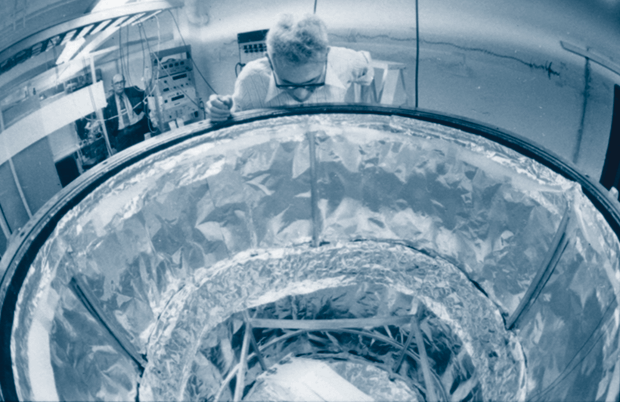
Yonah ben Yakov Weber was born in Paterson, N.J., in 1919, the youngest of four children of working-class parents who had emigrated from present-day Lithuania. He became “Joe” when his mother enrolled him in public school.
Joe Weber became even more Americanized—earning the nickname “Yankee” from his family—after he was hit by a bus at age 5 and lost the ability to talk. When he regained it, his Yiddish-influenced accent had been replaced by the middle-American diction of his speech therapist, says Virginia Trimble, a prominent astronomer whom Weber married in 1972 after the death of his first wife. Trimble collected stories of Weber’s early life in an unpublished manuscript.
Weber learned the joys of spinning dials and fine-tuning instrumentation early, building his first amateur radio set by age 10 and later accepting a job at a radio store. After high school, he won a coveted spot at the U.S. Naval Academy. There, Trimble wrote, the laser-focused Weber “stood first in his class in ‘thermodynamics, differential calculus, and other subjects of very little interest to the Navy,’ but nearly anchor in what is called ‘aptitude for the service’ (meaning, roughly, social graces).”
Social awkwardness didn’t stop Weber from becoming an officer on the aircraft carrier USS Lexington, on which he sailed out of Pearl Harbor two days before the Japanese attack on Dec. 7, 1941. During the Battle of the Coral Sea in 1942, he watched from a rescue boat as the burning ship sank into the darkened ocean. He told a Naval Academy interviewer: “When last seen by me, she was incandescent.”
Weber spent the insurance payment for property lost on the Lexington on an engagement ring for his high school sweetheart, physicist Anita Straus, whom he married that year. He took command of a speedy submarine chaser (he souped up the radar to improve detection of German boats) and helped guide the initial landing of the invasion of Sicily ashore in 1943. After the war, with a growing reputation as a technical whiz, he ran the Navy’s electronic countermeasures section. Weber left the service in 1948 at the rank of lieutenant commander.

In 1948, UMD administrators offered the promising young engineer a full professorship in electrical engineering. It came with the proviso that he earn a Ph.D.—in something—and soon. With a dawning interest in physics, Weber enrolled at Catholic University of America and researched microwave spectroscopy.
He made his first major scientific breakthrough in 1951 when he worked out the idea for the maser, a device to amplify microwaves that was the forerunner of the laser. He presented the first scientific paper about the device at a conference in 1952, but didn’t build one.
The three other scientists who later built prototypes—at least one of them first studied Weber’s paper—received the 1964 Nobel Prize in physics. Weber himself got little credit and was deeply stung by the machinations of scientific renown, several friends and colleagues say.
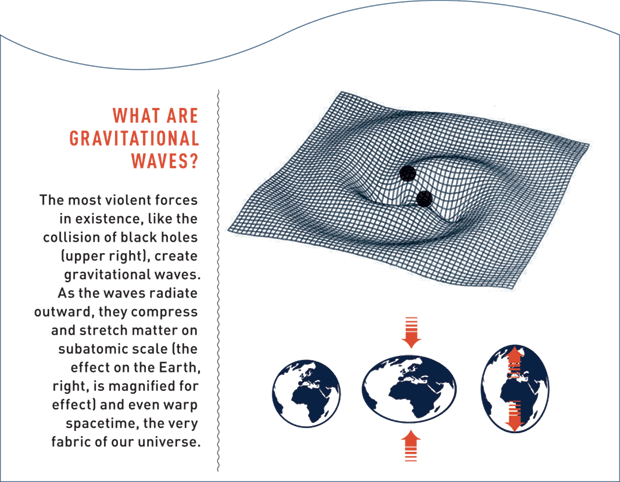
By then, however, Weber had already moved in another direction. Years later, he told Darrell Gretz, an engineer who helped him construct gravitational detectors and monitor tests, that he’d wanted to focus on “a field so difficult that no one would compete with me.” Late-night reading—one of his four young sons was chronically sleepless and frequently kept him up—had sparked a growing interest in Einstein’s gravitational theory, known as general relativity. In 1955–56, he took a sabbatical to study relativity with the leader in the field, Princeton University theoretical physicist John A. Wheeler. With Wheeler’s encouragement, Weber resolved to search directly for gravitational waves. It was a long-shot, high-reward gambit.
“Through late 1957, all of 1958, and early 1959, Weber struggled to invent every scheme he could for detecting gravitational waves,” physicist Kip Thorne, co-founder of the LIGO project and a Weber admirer, wrote in his book, “Black Holes and Time Warps.” “This was a pen, paper and brainpower exercise, not experimental. He filled four 300-page notebooks with ideas, possible detector designs, and calculations of the expected performance of each design. One idea after another he cast aside as not promising.”

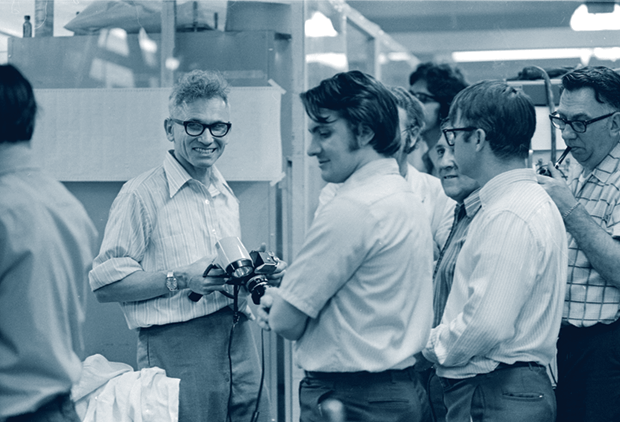
By 1959, the 40-year-old Weber had chosen a design using massive aluminum bars—in effect, cylindrical 3,000-pound bells that he believed gravitational waves would “ring” by minutely compressing, then stretching them.
Weber faced overwhelming early challenges, says Jean-Paul Richard, a UMD professor emeritus of physics who came from France in 1965 to work with him. At a time when many people doubted the existence of black holes and other sources of gravitational waves, Weber had to make educated guesses about the frequency of the waves created by such sources, and size his bars to match. He came very close, as later study showed.
“When he decided to build his device, there was no knowledge about gravitational waves or how you should start searching for them,” Richard says. “I’ve always been amazed at how original and ingenious his work was.”
The sensors Weber devised to measure changes in the bar, based on crystals that generate electricity when pushed and pulled, had to be unprecedentedly sensitive, Richard says. “You’re measuring displacements much smaller than the diameter of an atom.”
Weber relentlessly labored over the bars for a decade—12-hour days were commonplace, Gretz says—and shook the scientific world when he announced he’d verified Einstein’s prediction of gravitational waves in the real world.
Even before the 1969 publication of his paper “Evidence for the Discovery of Gravitational Radiation,” Weber’s growing renown inspired scores of physicists to devote themselves to studying gravitational waves. Among those drawn to UMD was Charles Misner, a professor emeritus of physics who helped shape modern relativity research and co-authored the landmark book “Gravitation.”
Students loved his energy as well. Physicist David G. Blair encountered him at a gravitation seminar at Louisiana State University. As Blair describes in his book “Detection of Gravitational Waves,” a classroom of postdocs was captivated by the “wiry and agile” Weber—a lifelong runner—darting back and forth in front of a chalkboard and enlivening complex theory with wry asides on academia and funding agencies.
“Never before and never since has mathematics on the blackboard brought tears of laughter to my eyes,” Blair wrote of the 1974 seminar.

That year marked a turning point for Weber. Since his 1969 discovery, groups worldwide had been constructing bar detectors, but none was confirming the gravitational waves Weber reported seeing frequently.
Scientific discord came to a head at a Massachusetts Institute of Technology gravitation conference. Richard Garwin, a widely respected physicist who played a key role in developing the first hydrogen bomb, had built a bar detector at IBM but found nothing. He now launched into a harsh critique based on fundamental errors in Weber’s data analysis. Weber’s heated response was perhaps more characteristic of a former warship captain than of a placid academic. As tension mounted, according to multiple published accounts, the conference chair, stricken by polio as a child, held his cane out to separate them.

Weber revised his data analysis practices and remained a respected scientist, particularly among those who had worked with him and seen firsthand his questing scientific spirit and seemingly limitless drive. But his reputation suffered as he refused to rethink his claims, instead focusing on revising earlier calculations to prove his points.
Freeman Dyson, a renowned physicist with whom Weber bonded during sabbaticals at Princeton, regretted earlier advice to his friend to stick by his findings, and now implored him to back down.
“A great man is not afraid to admit publicly that he has made a mistake and has changed his mind,” Dyson wrote in a letter, quoted in the book “Gravity’s Shadow” by sociologist Harry Collins. “If you do this, your enemies will rejoice but your friends will rejoice even more. You will save yourself as a scientist.”
Paik, who’d come to UMD from Stanford to improve Weber’s bar detectors with cryogenic cooling, asked his colleague to stop arguing and let the mechanisms of science decide.
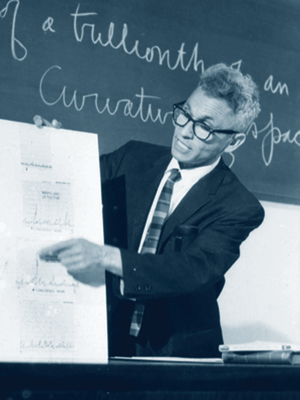
“Science is objective. You don’t have to continue to shout you found gravity waves,” Paik remembers telling him. But Weber had far less trust in those mechanisms than in the instruments he continually refined.
In the late 1980s, the National Science Foundation stopped funding his research. Weber also faced mandatory retirement at age 70 from UMD and the University of California-Irvine, where Trimble was a professor and where he’d worked part of each year as a visiting professor since their marriage. Elsewhere, the LIGO project was under way, using a different and potentially more sensitive method called laser interferometry, which detects gravitational waves through their effect on laser beams.
To Weber’s chagrin, LIGO was attracting far more government funding than his projects ever had.
“We’re No. 1 in the field, but I haven’t gotten funding since 1987,” he lamented in a Baltimore Sun article headlined “Pioneer researcher into gravity waves now a pariah in field.”
Now working alone as a research professor, Weber continued to fund his detectors out of his own pocket, reporting daily to his lab in the woods. Although exceptionally nimble for his age (Trimble reports he could climb an Olympic rope well into his sixties) he took a bad fall in an ice storm negotiating the hilly gravel road to the building. His broken bones didn’t heal correctly, and he suffered a recurrence of lymphoma during his recuperation. He died on Sept. 30, 2000.
Why did he persevere? Even though scientific detractors demanded “a pound of my flesh,” he told Thorne in a recorded interview (quoted in physicist Janna Levin’s book “Black Hole Blues”) that during the solitary hours in his remote laboratory perfecting instruments and studying data, he found fulfillment.
“If you do science, the principal reason to do it is because you enjoy it,” he said. “And I enjoy it.”

Ironically, Weber himself helped pioneer the basic concept behind LIGO, which succeeded where his instruments had failed.
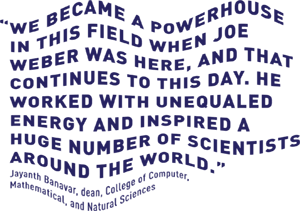 Colleague Jean-Paul Richard says he saw the idea outlined in the margins of one of Weber’s papers from long before LIGO began. At the February press conference in Washington, D.C., where widow Virginia Trimble sat in a place of honor in the front row, Thorne and others made sure to credit Weber as a key early contributor.
Colleague Jean-Paul Richard says he saw the idea outlined in the margins of one of Weber’s papers from long before LIGO began. At the February press conference in Washington, D.C., where widow Virginia Trimble sat in a place of honor in the front row, Thorne and others made sure to credit Weber as a key early contributor.
Today, few if any would deny Weber is the rightful father of gravitational wave research, or that his relentless work opened the door to viewing the workings of the universe in a whole new way—not with light or other electromagnetic waves that can be halted by veils of cosmic dust, but with gravity, which stops at nothing.
Tags
Research